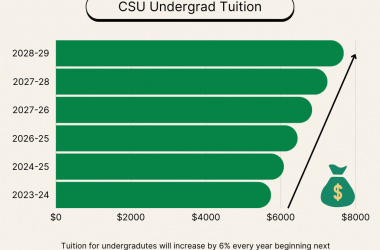Flags transformed into hazard signs, protests against nuclear power plants and messages of hope were showcased on campus during Gabriel Ritter’s lecture about art influenced by Japan’s 2011 Tohoku earthquake.
More than a dozen students and faculty gathered on Thursday in Academic Services, Room 384 to listen to Ritter, the Nancy and Tim Hanley Assistant Curator of Contemporary Art at the Dallas Museum of Art.
Tuesday marked the third anniversary of Japan’s Tohoku earthquake, which triggered a massive tsunami that killed 15,884 people and left another 2,633 missing. The 9.0-magnitude quake and tsunami also led to the Fukushima Daiichi nuclear disaster, according to the Japan Times.
Ritter said that his lecture was important not only because of the anniversary of the earthquake but because it also showcases many of the artists who usually don’t get much international exposure.
One of the pieces featured was a created by artist Chim Pom and called “Real Times,” in which a group of five artists went to the Fukushima Daiichi plant wearing homemade radiation suits. Once at the plant, they spray-painted a red hazard sign on a white banner, creating a makeshift Japanese flag.
“They started out by drawing [Japan’s flag]… then they transformed it into this international sign of radiation,” Ritter said. “They then place this sign similar to the Apollo moon landing …a sign that unlikely anyone else will come [to the Fukushima Daiichi plant] again.”
A piece by artist Niwa Yoshinori called “Walking In The Opposite Direction,” shows Yoshinori attending a protest against nuclear plants after Japan’s Tohoku earthquake. In the piece, Yoshinori walks in the opposite direction of the protesters.
Ritter said that he didn’t know how to feel when he first saw the piece.
“I was kind [of] pissed off,” Ritter said. “[It was] a demonstration against the demonstration.”
He also talked about artist Endo Ichiro, who is known as a social activist and community organizer in Japan. After the earthquake, Ichiro traveled often to the devastated areas like Fukushima to help people in need.
As part of Ichiro’s 2012 project “Rainbow Japan,” Ichiro traveled throughout Japan, writing messages such as “Jikkō-ka -nō setto wa iku,” or “Ready, set, go,” as a way of encouraging people to move forward with their lives following the disaster.
Ritter recently helped co-curate the exhibition “Roppongi Crossing 2013: OUT OF DOUBT” at the Mori Art Museum in Tokyo, which showcased many of the artists discussed in the lecture.
Comparative world literature professor Jordan Smith helped to organize the lecture, which was sponsored by the College of Liberal Arts Scholarly Intersection Grants and the Japan Arts and Globalization Multi-Campus Research Group (JAG-MRG).
Smith said he was pleased by the turnout of the event.
“I was extremely pleased that the crowd was so diverse,” Smith said. “The talk itself seems to be very well received.”
Senior political science major Rick Payan said he thought the lecture was effective.
“You never get to see what artists say about natural disasters, and it makes it a lot more interesting,” he said.




